
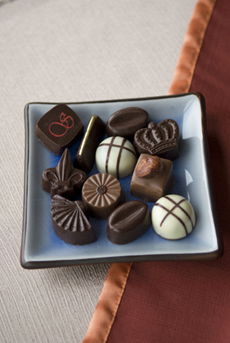 A dish of pralines, or Belgian molded chocolates, from Schocolat, a NIBBLE Top Pick Of The Week. Photo by Corey Lugg | THE NIBBLE. A dish of pralines, or Belgian molded chocolates, from Schocolat, a NIBBLE Top Pick Of The Week. Photo by Corey Lugg | THE NIBBLE.
March 2005
Last Updated June 2025
|
 |
Chocolate Glossary
Chocolate Terms & Definitions: P
On this page, you’ll find terms including percentage of cacao, porcelana cocoa, praline, premier cru chocolate, and pure origin chocolate. If you think we should consider chocolate terms and definitions other than those we have provided, click on the Contact Us link on this page. Also, enjoy our many other food glossaries.
Use this index bar to visit the appropriate glossary section.
a b c d e f g h i j k l m n o p q r s t u v w x y z
This glossary is protected by copyright and cannot be reproduced in whole or part.
You are welcome to link to it.
PALET
Palet (pah-LAY) is French for disc (i.e., a round, flat shape). Palet can have two different meanings for essentially the same thing: a round disc of plain chocolate. Palets are sold in bulk to chocolate and pastry professionals as couverture, to be melted down to make chocolate bars, bonbons, pastries, etc. Separately, bags of palets can be sold for consumer consumption.
|
|
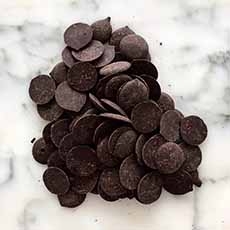
Palets for couverture (photo © Silverland Bakery)
|
PALET D’OR
Literally meaning “golden disc,” this chocolate began as a regional specialty and has expanded to general usage, referring to a pure ganache bonbon of dark chocolate. The original recipe, filled with coffee-flavored ganache, was created by confectioner Bernard Serardy in 1898. It was flat and irregular in shape, with a fragment of gold leaf as decoration. Today, chocolatiers make palets d’or with chocolate ganache as well.
|
|
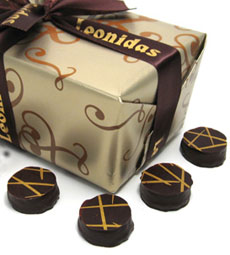
Palets d’Or from Leonidas.com.
|
PANNED
Panning is one of the four basic methods of coating chocolate onto a center (mostly hard centers such as nuts and crystallized ginger). The other methods are enrobing, panning, and molding or shell molding. In panning, chocolate is sprayed onto the centers as they rotate in revolving pans; cool air is then blown into the pan to harden the chocolates. On a small scale (and before the industrial revolution), nuts are coated on a pan on the stovetop; they can be rolled in cocoa powder or other coating before they harden.
PARTICLE SIZE
The basis by which chocolate smoothness is measured. The particles of the cacao beans and sugars are broken to such a small scale that the tongue is unable to detect individual particles. Generally, particle sizes of 14-18 microns are desirable.
PASTILLE
The word has evolved to mean many things over time. In candy and confections, it has two principal meanings: a small, hard, round, or oval fruit candy, often used as a lozenge, and a disk of chocolate. The pastille was popularized by Droste with a unique shape intended to fit into the soft palate: a rounded top intended for the roof of the mouth, and a smooth flat bottom on which the tongue could gently press the chocolate upwards. With this configuration, the pastille fits and melts perfectly in the mouth. Quality manufacturers such as Hachez make flat disks.
|
|
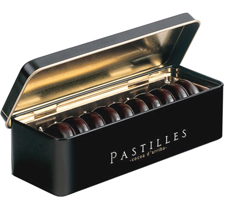
Hachez pastilles of 77% Ecuadorian Arriba cacao, among the finest pastilles made. More information.
|
PASTY
See thick.
PÂTE DE CACAO
Same as chocolate liquor.
PÂTE DE FRUITS
Fruit jellies, generally square or rectangular, are composed of sugar pulp and apple pectin. The fruit flavor is intense, as the fruit is more than 50% of the ingredients. Pronounced pot duh froo-EE, not pah-TAY, which is a different product, spelled the same but accented paté.
|
|
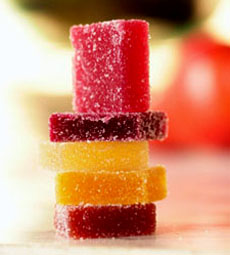
Pâte de Fruits from Recchiuti Confections in Pear-Lime, Passion Fruit, Apricot, Morello Cherry, and other delicious flavors. Read our full review of Recchiuti Confections.
|
PERCENTAGE OF CACAO
(1) The amount of cacao solids in a bar compared to other ingredients (e.g., sugar). Cacao is a combination of cacao mass, cocoa butter, and cocoa powder. The higher the percentage of cacao in a bar, the deeper depth of chocolate flavor, and the less sweet the chocolate. A recipe for chocolate includes cacao, sugar, vanilla, and an emulsifier, plus milk if it is milk chocolate. The higher amount of cacao replaces the corresponding amount of sugar in the recipe (an average milk chocolate has about 20% milk solids, and most chocolate contains 1% vanilla and emulsifier). Thus, 70% cacao chocolate has less sugar than 60% chocolate. Cacao percentages range from 30% cacao for some milk chocolates to 100% cacao, which has no sugar but is still enjoyed by some people for eating. Cacao percentage is only one factor in taste. Other variables include the type and quality of the bean, how the beans are roasted, how the chocolate is processed, the amount and type of sugar or other sweeteners, added flavorings, extra cocoa butter, etc. A higher percentage of cacao solids is not a guarantee of a better product. Good chocolate depends on the quality and origin of the beans and the manufacturer’s production techniques and blends (recipe); as well as the freshness of the chocolate. (2) According to the Chocolate Manufacturers Association, “% cacao” refers to the total percentage of ingredients (by weight) that come from the cacao bean (or cocoa bean), such as chocolate liquor, cocoa butter, and cocoa powder found in a chocolate product. (3) White chocolate has no cocoa solids (chocolate liquor): The “% cacao” refers to the cocoa butter. The higher the percentage, the creamier the white chocolate.
The use of the “% cacao” designation originated in Europe, where chocolates must be labeled to indicate the minimum total cocoa solids. “Cocoa solids” are often stated as “% Cacao” (France, Spain), “% Kakao” (Germany) or “% Cocoa” (U.K.). In the U.S., chocolate manufacturers are not required to declare the percentage. However, due to the increased consumption of fine imported chocolate bars bearing the designation, and consumer interest in learning more about chocolate, a trend has begun among American producers of better chocolate to add the designation.
POD or CACAO POD
The oblong fruit of the cacao tree. Pods measure six to 12 inches and ripen in five to six months. Inside are 30 to 40 half-inch-long, almond-shaped seeds, or beans, from which chocolate is made. Pods are harvested and cut open with a type of machete and are left as is to ferment. The beans are then scooped out and spread out in the sun to dry. Dried beans are graded and sold to chocolate producers.
|
|
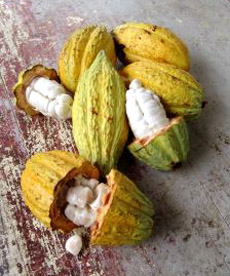 The inside of a pod reveals a pulpy
The inside of a pod reveals a pulpy
white fruit which is removed to get
to the seeds, a.k.a. the cacao beans.
Photograph courtesy SXC. |
PORCELANA
One of the rarest beans in the world, a genetically pure strain of the Criollo bean from the Andean region of Venezuela. It is named Porcelana for the pale, almost white-colored interior of the beans (although the nibs produce regular-colored cacao). It is believed that Porcelana cocoa was grown in the southwestern area of Venezuela as early as pre-Colombian times. According to historical sources, it seems that at the time of the Spanish conquest (the early 1500s), this cacao was being grown in the same area where Porcelana grows today.
|
In colonial times, Porcelana cacao was called Maracaibo, since it was primarily exported from the Venezuelan port of that name. Until the 1920s, Maracaibo cacao was classified as one of the world’s highest-quality cacaos, along with a few Mexican and Colombian strains. Unfortunately, Porcelana cocoa is not very resistant to disease, and the Mexican and Colombian cacaos of this genetic quality have died out, leaving behind hybrids with inferior organoleptic qualities. The unmistakable toasted almond flavor of the pure Venezuelan variety makes it a prized bean, and this rare bean produces some of the finest (and most expensive) chocolate bars in the world. Because of the limited supply of beans, only the finest chocolatiers have access and thus make a Porcelana bar: Amedei, Domori, Pierre Marcolini, and Valrhona.
|
|
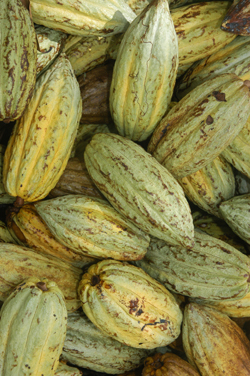
Porcelana pods. Photo courtesy of Amano Artisan Chocolate.
|
Flavors will vary by producer, but in addition to almonds, Porcelana typically yields strawberries, cream, butter, butterscotch, and sometimes bread flavors. The bars tend to be reddish-brown in color. To purchase a limited edition, 70% cacao Porcelana bar from Amedei, click here.
PRALINE
Perhaps the most complex term in chocolatedom, because it has so many different meanings. The first pralines (pray-LEEN in English, prah-LEEN in French) were whole almonds caramelized in sugar (i.e., the nut is roasted and coated lightly in sugar). Originally spelled praslines, they were named after the French soldier and diplomat César, duc de Choiseul, comte du Plessis-Praslin (his military title was marshal), who lived in the town of Montargis from 1598 to 1675. According to the story, the duke’s cook, Clément Lassagne, invented pralines in 1636 by dropping almonds into a cauldron of boiling sugar.
|
|
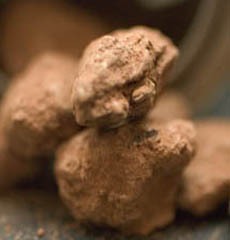
Caramelized nuts, here rolled in cocoa powder, from Cocoa Designs. |
After retiring from the duke’s service, Lassagne founded the Maison de la Praline, a confectioner’s shop that still exists in the town of Montargis in the same location, operated by a family named Mazet. They sell pralines made with the original recipe (you can find their products online). In the centuries since, the marketplace has taken the word praline and used it to describe multiple products. Whenever you see the word praline, nuts are involved; but the word often does not refer to the original caramelized almond.
- In Germany and Belgium, a praline is any filled chocolate, many of which are filled with ground nuts (praline paste). While the French-speaking Belgians call a filled chocolate a praline, the French-speaking French, who invented the caramelized nut praline, can also buy chocolates filled with praline paste called...pralines. In general, though, the French refer to assorted chocolates as chocolates or bonbons. In Great Britain, the term praline can refer to either the filling for chocolates, or less commonly, to the original almond pralines.
|
|
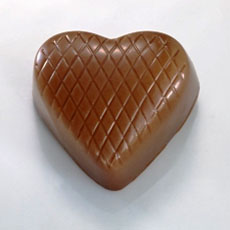
Michael Mischer’s salted caramel ganache in a chocolate shell would be called a bonbon in France, a praline in Belgium, or a truffle by some Americans, although a European chocolate truffle is something else entirely.
|
- This new usage is attributed to Belgian chocolatier Jean Neuhaus, who in 1912 developed a process using couverture as a hard shell for what he called pralines, which he filled with ganache, creams, nougats, etc. Other Belgian chocolatiers followed suit: Godiva, Leonidas, Neuhaus, and Nirvana.
- In Louisiana and Texas, a praline (pronounced PRAY-leen or PRAW-leen) is a flat, round, creamy candy patty dotted with crunchy pecans. Early Creoles began using local pecans as the nuts, instead of the almonds or hazelnuts used in the French confection. The product evolved into a candy made of brown sugar, butter, and cream and cooked to a soft-ball stage like fudge, but filled with pecans and spooned onto wax paper to form patties. It is called a praline but has absolutely nothing in common with French—or any European—pralines, except for the use of sugar and nuts.
|
|
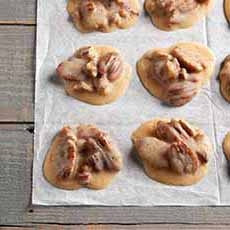
Southern pralines are brown sugar and pecan patties. These are available from WhaleyPecan.com.
|
- Praline also can refer to French praline powder—caramelized almonds or hazelnuts that are pulverized and sprinkled onto desserts.
- To add to the confusion, the French today also refer to pralines as dragées (drah-ZHAY). Dragées are also sugar-coated almonds, but technically, they are almonds encapsulated in a hard-shell coating, which we call Jordan almonds.
PRALINE PASTE or PRALINÉ
Praline paste, also called praliné (prah-lee-NAY), is a ground nut paste generally made from almonds or hazelnuts and sugar (the paste can be made from any nut; pistachio paste also is popular). It has been used in French patisserie since the 16th century to make pastries and to flavor mousse, buttercream, and ice cream. Hazelnut praliné is a roasted and caramelized nut paste invented during a chocolate shortage in the 19th century in Turin, Italy. In Italy, it is known as gianduja (jon-DOO-ya). It is popularly combined with chocolate and used in other confections.
PREMIER CRU CHOCOLATE
The term Chocolat Michel Cluizel and some other chocolatiers use it for their estate-grown chocolate. Abbreviated as 1er cru.
PRESS CAKE or PRESSED CAKE or TOURTEAU DE CACAO
An interim product in the production of chocolate, that remains after most of the cocoa butter has been pressed from the chocolate liquor by using massive hydraulic pressure. The resulting press cake is later pulverized into cocoa powder. The cocoa press was invented by Coenrad Johannes Van Houten, a Dutch chemist who took out a patent for it in Amsterdam on April 4, 1828. Van Houten also invented the alkalizing process known as Dutching.
PRESSING
The stage of chocolate-making in which the chocolate liquor is carried through hydraulic presses and the melted cocoa butter is extracted from the paste.
PRESTIGE CHOCOLATE
The most expensive category of chocolate. In the confectionery industry, chocolate is categorized by its price per pound at retail. The categories include Mass Market, less than $15 per pound; Mass Market Premium, from $15 to $25 per pound; Gourmet, from $25 to $40 per pound; and Prestige, at $40 per pound and higher.
PUGGING
The first rudimentary form of chocolate, after the mixture has been kneaded with the addition of vanilla, cocoa butter, and (if milk chocolate) powdered milk.
PURE ORIGIN CHOCOLATE
Chocolate that’s created with beans from one particular area or region. Also known as single-origin chocolate.
Continue To The Next Page: Terms With R
Go To Article Index Above
Lifestyle Direct, Inc. All rights reserved. Images are the copyright of their respective owners.

|













